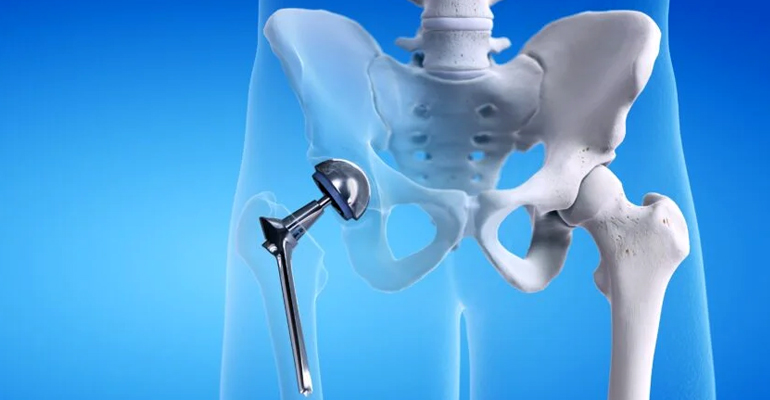-
-
+91-8591556577
-
Hip Replacement Surgery

Hip Replacement Surgery
Hip replacement surgery, or hip arthroplasty, is a procedure in which a damaged or worn-out hip joint is replaced with an artificial joint (prosthesis). This surgery is typically recommended for patients experiencing severe hip pain and reduced mobility due to arthritis, injury, or other hip-related conditions. Hip replacement helps alleviate pain, improve function, and restore quality of life for those whose daily activities are affected by hip joint problems.
When is Hip Replacement Surgery Needed?
Hip replacement surgery is usually considered for the following conditions:
- Osteoarthritis: The most common cause of hip pain and stiffness, where the cartilage cushioning the hip joint wears away, leading to bone-on-bone contact.
- Rheumatoid Arthritis: A chronic inflammatory condition that can damage the hip joint, causing pain and loss of movement.
- Hip Fracture: A severe injury, often in older adults, that can require surgery to replace the damaged joint.
- Avascular Necrosis: When blood supply to the hip bone is reduced or cut off, leading to bone collapse and joint damage.
- Hip Dysplasia: A congenital condition where the hip socket doesn’t fully cover the ball of the joint, leading to instability and damage over time.
- Other Conditions: Including hip deformities, tumors, or trauma that severely damages the hip joint.
When conservative treatments such as medications, physical therapy, or injections no longer provide relief, hip replacement surgery may be the most effective option.
Types of Hip Replacement Surgery
- Total Hip Replacement (THR): Involves replacing the entire hip joint—both the ball (femoral head) and the socket (acetabulum)—with prosthetic components.
- Partial Hip Replacement: Only the ball of the hip joint is replaced, often performed in cases of hip fractures.
- Hip Resurfacing: An alternative to total hip replacement, where the damaged surfaces of the hip are replaced with a smooth metal covering rather than removing the entire ball and socket.
The Hip Replacement Procedure
The hip replacement surgery typically involves the following steps:
- Preoperative Evaluation: Before surgery, your surgeon will assess your condition, perform imaging tests (X-rays or MRIs), and determine the best surgical approach.
- Surgical Procedure: During the surgery, the damaged cartilage and bone are removed. The artificial joint components—made of metal, ceramic, or plastic—are then implanted to restore smooth movement and functionality.
- Postoperative Care: After surgery, a personalized recovery plan, including physical therapy, is crucial to regain strength, mobility, and range of motion.
Recovery and Rehabilitation
Recovery from hip replacement surgery typically occurs over a few months, depending on the extent of the surgery and the patient’s health:
- Hospital Stay: Most patients stay in the hospital for a few days following the surgery, during which time pain management and mobility assistance are provided.
- Physical Therapy: Rehabilitation begins immediately to help strengthen the muscles around the new hip joint, improve flexibility, and restore normal walking patterns.
- Home Recovery: After leaving the hospital, patients continue with physical therapy and follow-up appointments to ensure proper healing.
- Full Recovery: Most patients regain full mobility and resume normal activities within 3 to 6 months. Regular exercise is essential to maintain hip function and overall health.
Benefits of Hip Replacement Surgery
- Pain Relief: The most significant benefit is the reduction or elimination of chronic hip pain, allowing patients to move comfortably.
- Improved Mobility: Hip replacement restores smooth joint movement, allowing patients to walk, climb stairs, and engage in daily activities without discomfort.
- Enhanced Quality of Life: Hip replacement surgery helps patients return to an active lifestyle, free from the pain and limitations caused by hip joint problems.
Risks and Complications
As with any surgical procedure, there are potential risks associated with hip replacement, including:
- Infection at the surgical site
- Blood clots
- Implant loosening or dislocation over time
- Nerve or blood vessel damage
- Leg length differences post-surgery
However, with advanced surgical techniques and comprehensive post-surgical care, the chances of complications are minimal, and most patients experience successful outcomes.
Why Choose Us for Hip Replacement Surgery?
- Expert Surgeons: Our highly experienced orthopedic surgeons use the latest technology and minimally invasive techniques to ensure the best outcomes.
- Personalized Care: We tailor each treatment plan to the patient’s specific needs, ensuring a smooth and successful recovery process.
- Comprehensive Rehabilitation: Our postoperative rehabilitation programs focus on helping patients regain strength and return to their normal activities as quickly as possible.
